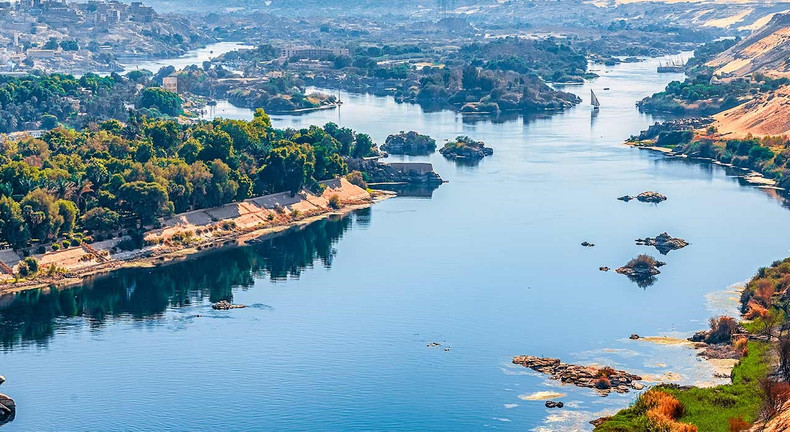The Nile (also known as the Nile River) is a major north-flowing river in northeastern Africa. It flows into the Mediterranean Sea and is the longest river in Africa. While historically considered the longest river in the world, recent research suggests that the Amazon River may be slightly longer. The Nile is one of the smallest of the world's major rivers when measured by annual flow in cubic meters of water. It spans about 6,650 km (4,130 mi) and its drainage basin covers eleven countries: the Democratic Republic of the Congo, Tanzania, Burundi, Rwanda, Uganda, Kenya, Ethiopia, Eritrea, South Sudan, Sudan, and Egypt. The Nile is the primary water source for Egypt, Sudan, and South Sudan, and it plays a crucial role in supporting agriculture and fishing.
The Nile has two main tributaries: the White Nile and the Blue Nile. The White Nile, traditionally considered the headwaters stream, is longer and originates in the Great Lakes region, beginning at Lake Victoria and flowing through Uganda and South Sudan. On the other hand, the Blue Nile, originating at Lake Tana in Ethiopia, contributes 80% of the water and silt downstream. The Blue Nile flows into Sudan from the southeast, and the two rivers meet at the Sudanese capital of Khartoum.
The northern section of the Nile flows almost entirely through the Nubian Desert to Cairo and its large delta, ultimately emptying into the Mediterranean Sea at Alexandria. Egyptian civilization and Sudanese kingdoms have relied on the river and its annual flooding since ancient times. Most of the population and cities of Egypt are located along the Nile valley north of the Aswan Dam, and the cultural and historical sites of Ancient Egypt developed along the river banks. The Nile, along with the Rhône and Po, is one of the three Mediterranean rivers with the largest water discharge.
Course
The Nile is one of the longest rivers on Earth, stretching about 6,650 km (4,130 mi) from Lake Victoria to the Mediterranean Sea. Its drainage basin covers 3,254,555 square kilometers (1,256,591 sq mi), which is approximately 10% of Africa's total area. Despite its length, the Nile carries relatively little water compared to other major rivers, accounting for only 5% of the Congo River's water volume. The river's flow is influenced by various factors such as weather, diversions, evaporation, evapotranspiration, and groundwater flow.
Upstream from Khartoum in the south, the Nile is referred to as the White Nile. The White Nile originates in equatorial East Africa and is also used in a limited sense to describe the section between Lake No and Khartoum. At Khartoum, the Blue Nile joins the river. The Blue Nile begins in Ethiopia, while both branches are located on the western flanks of the East African Rift.
